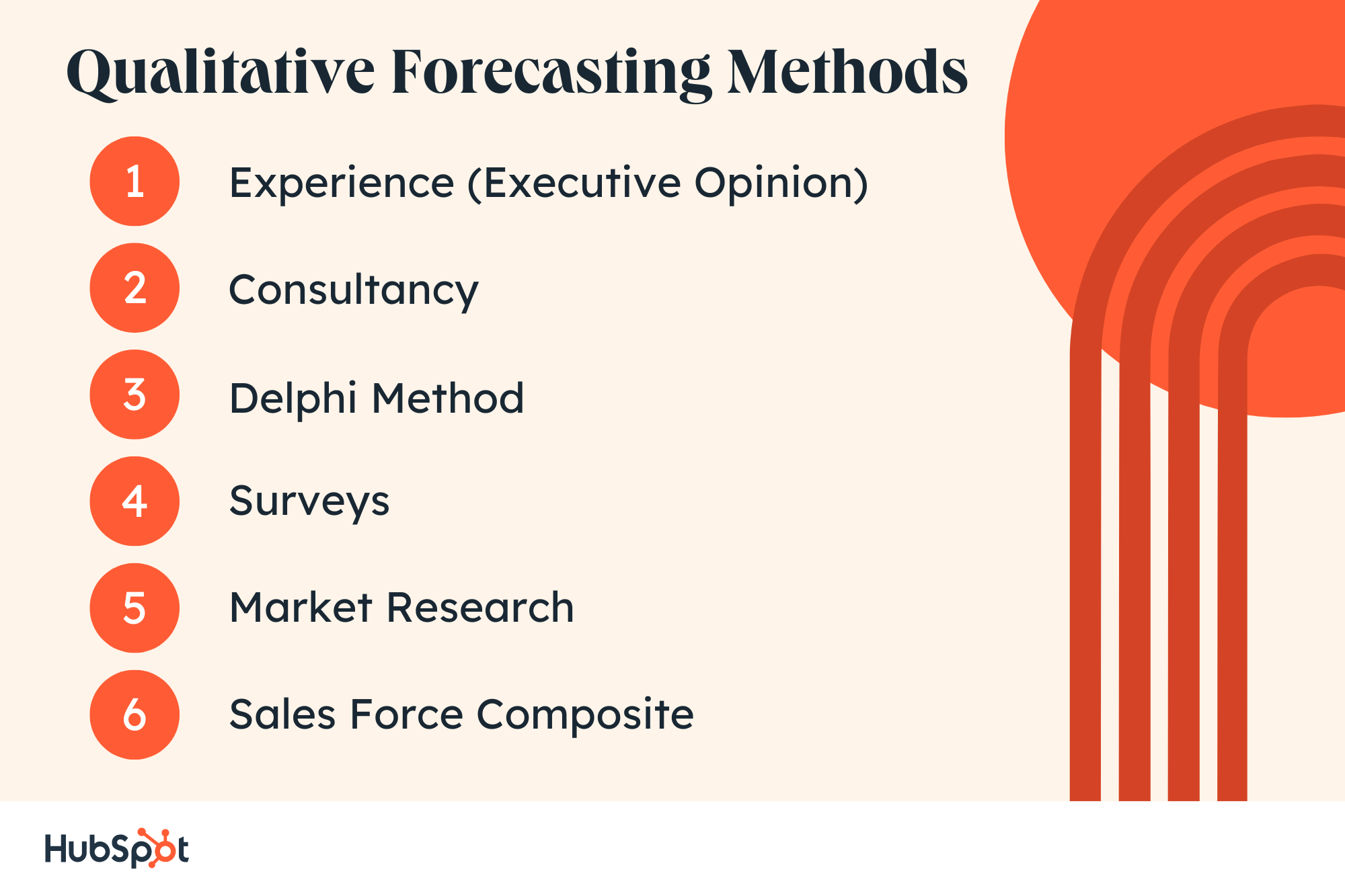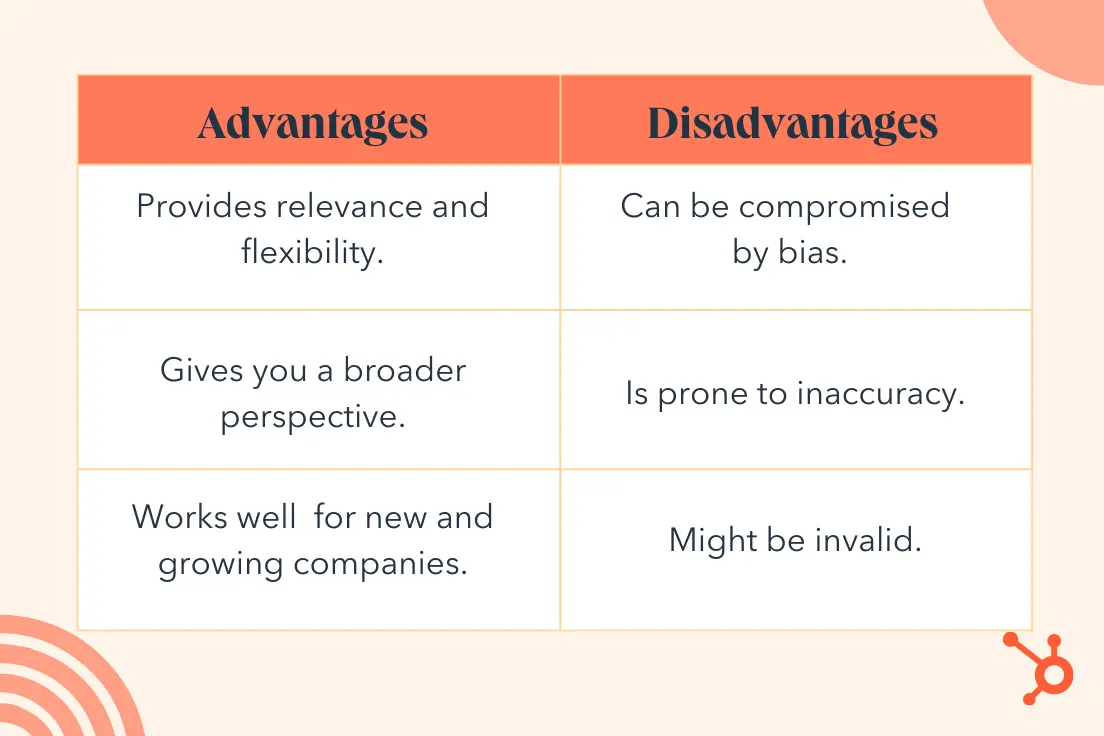Table of Contents
- What is qualitative forecasting?
- Benefits of Qualitative Forecasting
- Qualitative Forecasting Methods and Techniques
- Qualitative Forecasting Examples
- Advantages of Qualitative Forecasting
- Drawbacks of Qualitative Forecasting
There's no denying that numbers are a crucial part of any sales forecast — you should never try to put one together without them. But as touched on earlier, hard figures can't always give you a complete enough picture to inform an accurate forecast.
Qualitative forecasting fleshes out a more thorough understanding of customer and market behavior — helping businesses account for more angles and potential curveballs when conducting their sales efforts over a fixed period.
Benefits of Qualitative Forecasting
Qualitative forecasting helps when companies explore new sales methods or expect sales to deviate from the typical results. As companies grow, they might find themselves in uncharted territory — setting unprecedented goals and making plans they're not well-acquainted with. Here's why qualitative forecasting is so important in those situations.

Alt: Benefits of Qualitative Forecasting. Uses leading indicators instead of lagging indicators. Accounts for more variables. Uncovers expert insights.IMG name: qualitative-forecasting-benefits
Qualitative forecasting uses leading indicators instead of lagging indicators.
A study by Gong highlighted that while 63% of sales professionals considered sales forecasting extremely critical to the success of their business, only 27% said that it produces accurate results.
Forecasting based purely on historical data doesn't account for economic fluctuation, upcoming technologies, or unexpected market trends. In times of unprecedented change, qualitative forecasting accounts for external market conditions and helps you anticipate the impact of a given variable on your sales cycle — rather than trying to identify its consequences in hindsight.
Qualitative forecasting accounts for more variables.
Quantitative forecasting is traditionally limited to measurable objectives like revenue, customers, and product units sold. But qualitative forecasting is more expansive — it considers subjective elements like customer satisfaction, brand perception, and employee engagement.
Including those less tangible variables helps you anticipate the demand for your products or services in a given market — providing better insight into how much effort you need to put into a campaign and where your focus should lie.
Qualitative forecasting uncovers expert insights.
Armed with the right qualitative data, you can draw on the experience and knowledge of industry experts to inform your decisions. Use their firsthand insights to anticipate customer behaviors and better understand what needs to be done to move forward.
Qualitative forecasting helps you identify where there might be potential gaps between expectations and reality — helping you make more meaningful and informed decisions.
Qualitative Forecasting Methods and Techniques
So how do you approach qualitative forecasting? There are several ways to go down this path.
Alt: Qualitative Forecasting Methods. Experience (Executive Opinion). Qualitative Forecasting Methods. Consultancy. Delphi Method. Surveys. Market Research. Sales Force Composite.IMG name: qualitative-forecasting-methods
1. Experience (Executive Opinion)
In many cases, some of the necessary insight and information to inform effective qualitative forecasting can come from within the company — typically from leadership.
Managers (or occasionally regular employees) might already have extensive knowledge of or experience with a certain market, product, or customer base. In those instances, they can be an excellent resource for assisting with qualitative forecasting.
2. Consultancy
Not every business has leadership seasoned enough to put together reliable qualitative forecasts based on personal experience — especially if a company is younger and scaling.
That's why companies often outsource their qualitative forecasting responsibilities to third parties. Consultants with a more developed pulse on an industry, market, or customer persona can be an excellent resource for a company struggling with qualitative forecasting.
3. Delphi Method
The Delphi Method is similar to the ones listed above in that it relies on experts, but the process is a bit more elaborate and sophisticated than most others. Instead of just asking experienced managers or consultants for their opinions off-hand or collaboratively, the method involves questioning multiple parties about a sales forecast separately to prevent groupthink.
The risk you run when leveraging the Delphi Method is a lack of consensus. If too many experts offer varying perspectives, it can be hard to piece together a cohesive, accurate qualitative forecast.
4. Surveys
Surveys are another way to inform thoughtful, effective qualitative forecasting. This method is one of the more tried-and-true, relatively accessible options listed here. Hearing directly from your target audience helps you tailor a forecast backed by firsthand qualitative insight.
A well-constructed survey gives you insight into new markets, helps you understand shifting tides within your industry, and allows you to identify your customers' collective tendencies better. With several applications to create and distribute surveys at your disposal, this method is worth considering when putting together qualitative forecasts.
5. Market Research
When a business plans to enter a new market, it can use market research to boost its qualitative forecasting. This practice helps a company determine if breaching a new market is worth the effort and resources.
It also offers perspective on what potential new customers are looking for from the business. Resources like focus groups, product testing surveys, and polls can all be used when leveraging this method.
6. Sales Force Composite
Your sales team interacts with your customers more closely than anyone else and possesses a wealth of firsthand knowledge about customers’ buying habits.
The sales force composite forecasting method draws the insights of salespeople, sales management, and other channel members to produce sales forecasts. Train salespeople on how to forecast accurately, explicitly emphasize the importance of this market intelligence, and regularly review the data they provide to control the quality of your forecasting.
Qualitative Forecasting Examples
Virtually any significant decision any business makes can benefit from qualitative forecasting techniques.
When a company is either just starting or getting off the ground, its leadership will likely need to account for market research to determine if its idea, offering, business model, messaging, pricing, and marketing are viable.
In those cases, the organizations in question don't have existing numerical data to analyze and rely on — making accurate quantitative forecasting nearly impossible. Instead, those companies have to take different, more creative roads to produce a solid picture of what they can expect from their sales efforts and target prospects.
Qualitative forecasting is also an asset for more mature companies looking to release a new product or service. Quantitative methods can only get you far if you've never sold a specific offering. That's why businesses in this position generally look beyond those strategies to accurately understand what's to come.
Scenario 1: Launching a New Product
A tech giant like Samsung wants to introduce a new smartphone. Apple is the current market leader, and Samsung hopes this new product, which revolutionizes the OS, will give them an edge.
The problem is the global economy is heading into a recession, and this smartphone is 1.5x the price of its competitors. Samsung wants to gauge whether this new product is a wise financial decision and whether customers have the purchasing power to make it worthwhile.
The company can't rely on quantitative forecasting alone since inflation has risen in the past two months, and it might not be the best time to launch. Samsung turns to market research to understand how much customers are planning to spend on tech in the next quarter and how they perceive the value of their new, revolutionary product.
Scenario 2: Expanding Into a New Market
A mass fashion retailer like Zara wants to expand into the East Asian market and produce clothes representing local culture. It doesn't want to risk committing a faux pas by wrongly representing local trends, so it turns to qualitative forecasting.
The company looks for local influencers, surveys customers in the new market, and runs focus groups to get an accurate representation of what people want. It learns that launching a new brand instead of marketing existing products is the way to go and that locals respond better to combining traditional and modern elements.
A majority East Asian team is also a better way to approach this expansion since locals are more likely to trust the brand if people from their own culture represent it.
Advantages of Qualitative Forecasting
For some sales leaders, using anything besides numerical analysis in sales forecasting can seem intimidating or pointless — but qualitative forecasting offers several advantages that extend beyond those of its quantitative counterpart.
Qualitative forecasting provides relevance and flexibility.
Qualitative forecasting doesn’t care about last year’s sales numbers. Instead, it does care about more timely, relevant information, such as new technology your business has adopted or global trends that may affect the economy.
Qualitative forecasting takes non-numerical events and assigns weight to how they might impact a company's performance and operations — offering that business higher flexibility in its decision-making when those variables take hold.
Qualitative forecasting gives you a broader perspective.
When paired with quantitative forecasting, qualitative forecasting can give a company a holistic look at virtually every factor — both objective and subjective — when considering a significant decision.
This point is particularly relevant to larger companies with historical numerical data and the resources to supplement it with internal or external expertise and market research. With the ability to deliver on both sides of the forecasting token, these businesses can reliably make comprehensive, accurate sales predictions.
Qualitative forecasting works particularly well for new and growing companies.
While larger enterprises likely have reliable quantitative data to pair with qualitative insight, startups, and small businesses might not be so lucky. In most cases, those companies haven't been around long enough to accrue a significant bank of hard sales figures — making qualitative data central to their forecasts.
Drawbacks of Qualitative Forecasting
Though qualitative forecasting has tremendous upsides, it still comes with its fair share of drawbacks.
Qualitative forecasting can be compromised by bias.
Whether a company turns to skilled employees, consultants, or customer insights, it risks compromising insight with bias. Qualitative data is inherently subjective, and subjective information is naturally prone to bias.
Qualitative forecasting is prone to inaccuracy.
Without definite numbers to rely on, qualitative data can produce incorrect results due to manual errors. This point ties into the one above — biased data is generally naturally inaccurate.
For instance, a customer might respond to a survey or poll a business is running to vent about a single negative experience. Or, a manager relying on past experiences to inform forecasts might bring too personal a spin to the process or see past events and trends through a warped lens.
Qualitative forecasting might be invalid.
Hired consultants or expert panels outside the business can provide a different perspective, but their separation from the company could render their forecasts invalid. Companies turning to subjective insights risk receiving illegitimate or irrelevant forecasts.

Alt: Qualitative forecasting pros and cons. Advantages. Provides relevance and flexibility. Gives you a broader perspective. Works well for new and growing companies. Disadvantages. Can be compromised by bias. Is prone to inaccuracy. Might be invalid.IMG name: qualitative-forecasting-pros-cons
Use Qualitative Forecasting for Improved Decision-Making
Any time a business needs to make a decision or step forward, it needs a comprehensive forecast to help set goals, milestones, and expectations. Data analysis can always help guide a business, but quantitative data doesn’t always provide the whole picture.
That’s why qualitative forecasting is so important. It can provide deeper insight that considers varying viewpoints, experiences, and real-world events, letting a company be as prepared as possible to move forward effectively.
Sales Forecasting

.jpg)

![How to Choose the Right Forecasting Technique [+ Expert Insight and Data]](https://53.fs1.hubspotusercontent-na1.net/hubfs/53/forecasting-methods-1-20241205-4072635.webp)
-Feb-24-2025-07-49-23-4986-PM.png)







![I Took a Deep Dive Into Trend Forecasting: Here’s What I Learned [+ Expert Tips]](https://53.fs1.hubspotusercontent-na1.net/hubfs/53/trend-forecasting-1-20241114-1048511.webp)